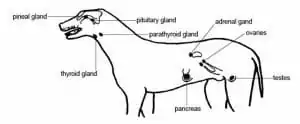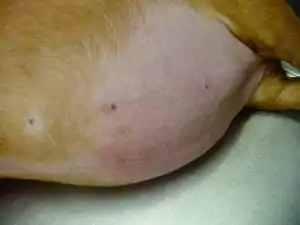Cushing’s disease in dogs is a serious condition that can often be overlooked in the eyes of pet owners. Cushing’s disease can be life threatening, so it’s important to know how this disease affects our pets and the signs to look for. Proper diagnosis and a clear understanding of the disease is important in the long term management.
What is Cushing’s disease in a dog?
Cushing’s disease is a condition in which an overproduction of hormones are produced by the adrenal glands (hyperadrenocorticism). The adrenal glands produce many vital substances that regulate several body functions. One of the most important substances produced by the adrenal gland is cortisol, which helps the body combat stress. Any decrease or excess of this hormone can cause a major disruption in a dog’s body, which can be life-threatening. Since Cushing’s disease is an overproduction of cortisol, this condition can cause serious health concerns among those affected.
What causes Cushing’s disease?
Though the one definition of Cushing’s disease is an overproduction of cortisol, there are a few different ways that a dog can become a Cushing’s patient. Knowing the exact cause of the disease is imperative in knowing the prognosis of each individual dog.
Pituitary Gland Tumor: The most common cause of Cushing’s disease is a tumor on the pituitary gland. The tumor causes an overproduction of the ACTH hormone, which triggers the adrenal glands to produce cortisol. These tumors can be benign or malignant, and cause a variation of different symptoms. Some symptoms will only be related to Cushing’s, while some patients will experience neurological symptoms as well. This all depends on the type and the size of the tumor.
Adrenal Gland Tumor: Cushing’s disease can be caused by a tumor on the adrenal gland. This tumor can be benign or malignant. In cases where the tumor is benign, removal of the tumor often results in a cure of the disease. If the tumor is malignant, the prognosis is often poor.
Prolonged Steroid Use: Cushing’s disease can be caused by an excessive use of steroids. Though the steroids are often given in situations where they are needed, the excess amount can be dangerous.
What are the symptoms of Cushing’s disease?
The symptoms of Cushing’s disease are very often similar from case to case. Most pet owners’ often notice:
- Increased thirst
- Increased appetite
- Increased urination
- Thinning of the skin/ chronic skin infections
- Hair loss
- Slow hair growth
- Enlarged abdomen/ pot-bellied appearance
- Lethargy
- Excessive panting
How is Cushing’s disease diagnosed?
There are a few tools that are necessary in properly diagnosing Cushing’s disease. Along with an evaluation of the pet’s history, blood and urine diagnostics are necessary in detecting hormone levels that will be elevated in cases of Cushing’s disease. While these diagnostics can be extremely helpful in detecting the disease itself, further diagnostics are necessary to learn the exact cause. An abdominal ultrasound is also extremely helpful in the diagnosis of Cushing’s disease.
Is there a treatment for Cushing’s disease in Dogs?
The treatment and management of this disease relies entirely on the cause of the disease itself. Like discussed previously, there are three types of Cushing’s disease. In the cases where a pituitary tumor is the cause, the drugs trilostane or mitotane will be used to manage the disease. When dealing with an adrenal tumor, abdominal surgery will have to be considered. Since the resolution of the disease relies on the tumor removal, surgery will be the solution. If the adrenal tumor is malignant, surgery may not be a resolution. When steroids are the cause of the disease, discontinuation of the steroids is necessary. This can be difficult, as there will need to be a gradual removal of the steroids being given. Discontinuation of the steroids can also result in the return of the condition that was originally being treated by the steroids. That can result in complications in itself.
How long does a dog live with Cushing’s disease?
Depending on the exact cause of the disease, Cushing’s patients can be generally well managed. The likelihood of a longer and healthier life relies completely on proper diagnosis of the disease, follow up diagnostics and the compliance of the pet owner. Depending on the cause, lifelong treatment may be necessary.
What should I keep in mind?
While Cushing’s disease may seem like a daunting diagnosis, it is important to keep in mind that this condition can be managed. An early diagnosis of the disease can help to prevent a poor outcome, so watching your pet closely is extremely important. Make sure to monitor your pets appearance, along with their food and water consumption, as this can help you determine if there may be a medical problem brewing.
Learn more about other serious conditions such as Tick-borne diseases linked to kidney problems in pets, that can affect your pet!



